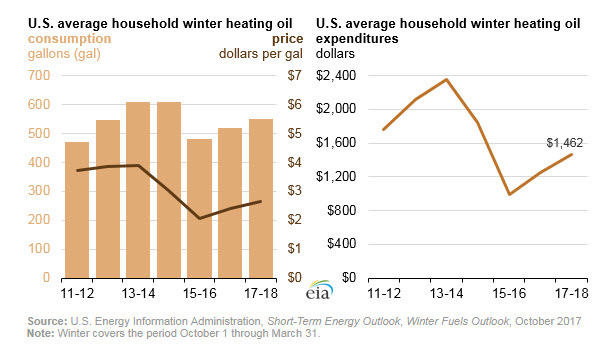
Winter Heating Costs likely to be Higher This Winter than Last Winter
Editor’s Note: The EIA will release its Winter Fuels Outlook today at 11:00am, giving an outlook on expected fuel prices and trends during the winter, as well as a forecast of expected cold weather. This is important for energy consumers because it affects both their natural gas demand and gives an outlook of what type of winter weather to expect. For diesel users in cold areas, having a simple, effective winter fuel strategy is essential.
Most U.S. households can expect higher heating expenditures this winter (October through March) than the last two winters according to EIA’s Winter Fuels Outlook, which will be released at 11:00 a.m. today. Higher expected winter heating expenditures are the result of both more heating demand because of relatively colder weather and, to a lesser extent, higher fuel prices.
EIA’s projections of heating demand are based on the most recent temperature forecasts from the National Oceanic and Atmospheric Administration (NOAA). NOAA’s forecast anticipates that winter weather will be 13% colder than last winter and closer to the average of the previous 10 winters.
Because weather patterns present great uncertainty to winter energy forecasts, EIA’s Winter Fuels Outlook includes projections for 10% colder and 10% warmer scenarios. In the past 10 winters, actual temperatures have been more than 10% colder than NOAA’s September forecast once and warmer than the forecast twice.
The average household winter heating fuel expenditures in EIA’s forecast provide a broad guide to expected heating expenditures. Fuel expenditures for any household also depend on the size and energy efficiency of the home and its heating equipment, indoor temperature preferences, and local weather conditions.
The choice of primary heating fuel varies considerably by region, resulting in regional differences in total expenditures. Natural gas is the most common space heating fuel in every region except the South, where electric heating is more prevalent. Heating oil is much more common in the Northeast than in other regions, while propane is more common in the Midwest.
More information about EIA’s expectations of winter fuels prices and expenditures is available in the Short-Term Energy Outlook supplement on winter fuels, released at 11:00 a.m. today.
The National Association of State Energy Officials (NASEO) and EIA will host a 2017–2018 Winter Energy Outlook Webinar this morning from 11:00 a.m. to 1:00 p.m. Eastern Time. The webinar will address global oil supply uncertainty and the effects of projected winter weather on the demand for heating fuels and key transportation fuels.
This article is part of Alerts
Tagged:
MARKET CONDITION REPORT - DISCLAIMER
The information contained herein is derived from sources believed to be reliable; however, this information is not guaranteed as to its accuracy or completeness. Furthermore, no responsibility is assumed for use of this material and no express or implied warranties or guarantees are made. This material and any view or comment expressed herein are provided for informational purposes only and should not be construed in any way as an inducement or recommendation to buy or sell products, commodity futures or options contracts.








